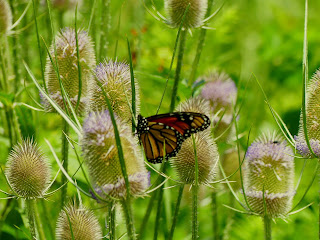Monarch III - The Return of the Butterfly
Here's yet another Monarch butterfly from last July. Previously I talked about what they eat and how they grow, yet the other interesting thing about Monarch butterflies is their migration.
I'm going to talk about the 2 big migrations here in the US. Apparently there are Monarchs in Australia and New Zealand that migrate relatively short distances, and other populations (mostly outside the US) that don't migrate at all.
The first thing to realize is that most Monarchs don't engage in a long migration route. If you're a Monarch that hatches in spring or most of the summer, you may stay in the area (perhaps if milkweed and nectar are abundant), but there's a good chance you'll want to migrate north (where the milkweed is younger and is less likely to have been eaten by your generation). After (hopefully) successfully breeding in your new northern home, you'll die of old age and your kids will engage in the next northward migration. It's only when you're an autumn Monarch that things change; this is the so-called super generation, and this generation flies all the way south to their winter homes, (hopefully) survives the winter, and then breeds in the spring to trigger the start of the northern migration again. So it probably takes 4-5 generations of Monarchs to get to the northern-most reaches of their range, but only 1 generation to retreat to their southern winter homes.
And technically there are two similar but distinct stories here, since our Monarch butterflies consist of 2 fairly separate subspecies separated by the Rocky Mountains. When winter approaches, the Western Monarchs (who may be facing extinction) migrate down to southern California to spend the winter in Eucalyptus trees, while the Eastern Monarchs head down to Mexico to shelter in Oyamel Fir trees.
The Eastern Monarchs of the super generation embark on one of the longest known insect migrations. The only one I know of that's longer is by Old World Painted Lady butterflies that migrate from Siberia to Africa.




Comments
Post a Comment